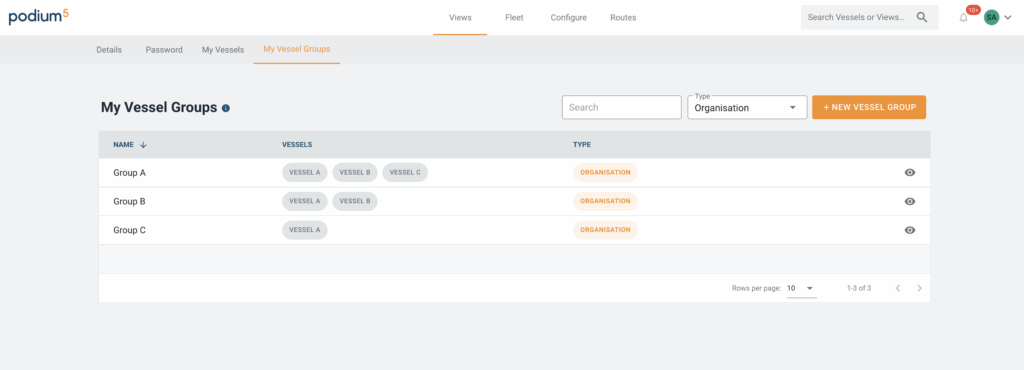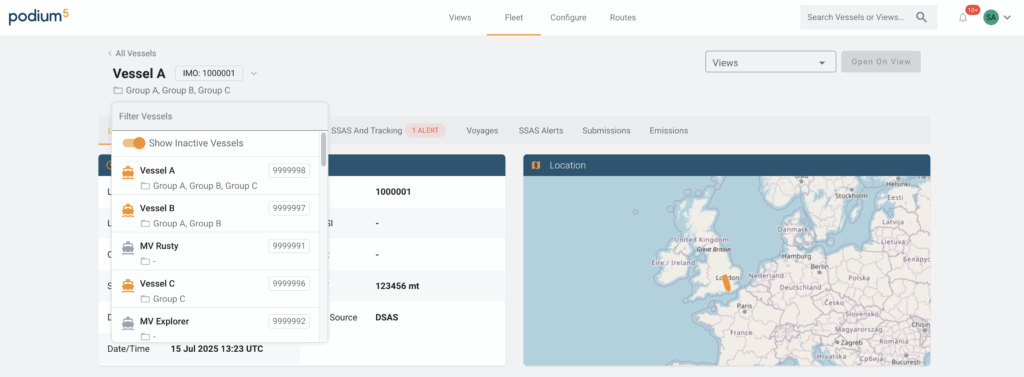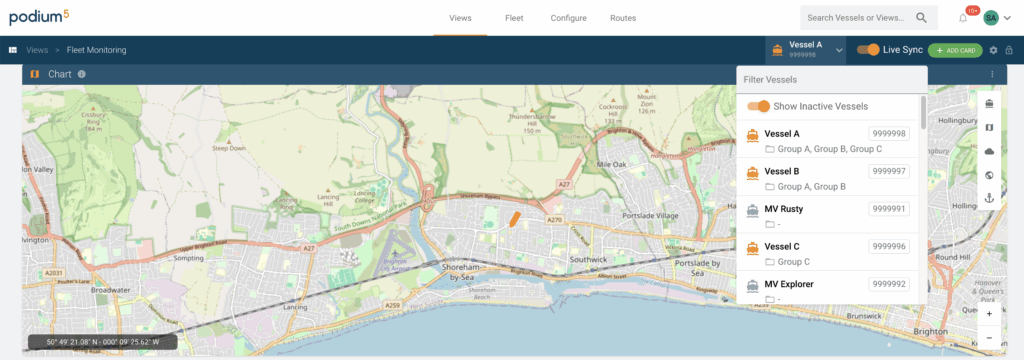This month, we’ve released a series of powerful updates across Podium, PurpleTRAC, MDA, and our API platform—focused on streamlining vessel management, strengthening compliance, and improving operational flexibility.
Podium (Shipping & Offshore)
Upgraded Fleet Management in Podium
Managing large and complex fleets just got easier. This update introduces a more intuitive and scalable Fleet Management experience in Podium, focused on simplifying the day-to-day work of Admin and End Users alike.
Key Enhancements:
- Renamed tabs make navigation more intuitive for Admin users


- Improved workflows for assigning vessels and creating vessel groups

- Tooltips across key UI areas provide quick guidance and reduce guesswork

- Standardized vessel status display ensures consistent visibility across the Fleet page and Views


- Updated filters and grouping options give users more control over how vessel data is viewed and managed

Why it Matters:
These improvements reduce the time and effort required to manage fleets, improve cross-user consistency, and pave the way for automation features in future Podium releases.
PurpleTRAC (Maritime Risk & Compliance)
STS Pairing Vessel Screening
June’s PurpleTRAC updates focus on expanding compliance visibility, with new capabilities that allow for deeper vessel risk assessment and greater enforcement of internal screening policies.
Ship-to-Ship (STS) Pairing Vessel Screening
You can now screen vessels involved in Ship-to-Ship (STS) pairings alongside the primary vessel. When a screening is initiated, PurpleTRAC will also apply sanctions, movement, and PSC history checks to any known paired vessels involved in STS activity.
Why it Matters:
STS operations are often used to obscure illicit trade or evade sanctions. Screening all vessels involved in these operations helps close a critical due diligence gap.
P&I Club Screening
PurpleTRAC now incorporates Protection & Indemnity (P&I) Club information into the Company & Country Watchlist screening module. This means users can evaluate a vessel’s insurer as part of the compliance review process.
Why it Matters:
The reputation and reliability of a vessel’s insurer is a key indicator of operational integrity. This feature helps teams flag poorly insured vessels or those backed by disreputable underwriters.
Vessel Age Screening
Vessel age is now displayed during screenings, and alerts are triggered if a vessel exceeds your organization’s predefined age threshold. The severity level is automatically applied based on the rules you configure in your account settings.
Why it Matters:
Older vessels are more likely to face mechanical failure or regulatory scrutiny. This feature ensures you remain aligned with internal policies and reduces operational and safety risks.
MDA (Global Government Solutions)
Precision matters when you’re tracking vessels in open water or planning operations in remote regions. This release brings a long-requested feature to the MDA map interface: search by geographic coordinates.
Users can now locate positions using:
- Decimal Degrees (DD) – e.g., 12.3456, -45.6789
- Degrees, Minutes, Seconds (DMS) – e.g., 12° 20′ 44″ N, 45° 40′ 44″ W
Support for named locations like “Panama Canal” remains unchanged.
Why it Matters:
This capability is essential for operations in offshore zones without traditional place names. It enables exact pin drops, surveillance planning, and real-time monitoring with accuracy—vital for defense, enforcement, and global intelligence workflows.
API & Platform Enhancements
Our API platform has received several enhancements this month to improve fleet scalability and monitoring flexibility.
Fleet Management API – Custom Vessel Groups
Users can now create and manage vessel groups via API, allowing full programmatic control of fleet structures.
New Capabilities:
- Create custom vessel groups
- Add or remove vessels in bulk
- Track metadata for each group
Why it Matters:
This eliminates the need to manage fleets in spreadsheets and supports automated updates for dynamic operations across large fleets.
Fleet-Based Vessel Notifications
Notification management is now significantly easier. Instead of setting up alerts for each vessel individually, users can subscribe to entire fleets.
How it works:
- Subscriptions update automatically as vessels are added or removed
- Only one notification subscription is needed per fleet
Why it Matters:
This reduces configuration time, prevents gaps in monitoring coverage, and helps teams focus on what’s critical without being overwhelmed by alerts.
Custom Circular Zone Creation
You can now define custom circular zones for maritime monitoring in any location on the map.
Key Use Cases:
- Proprietary anchorages
- High-risk corridors
- Government-controlled maritime boundaries
Why it Matters:
Standard zone libraries don’t always reflect operational realities. This feature gives users the power to define and monitor zones that match their unique business, security, or regulatory needs.
Infrastructure & Performance Improvements
We’ve also made foundational improvements to backend systems to improve global performance.
Upgrades include:
- Faster page loads
- Better system stability under load
- Improved API response times
Why it Matters:
These changes enhance the platform experience across all user regions and ensure smooth operation during high-demand periods.
What We’re Working on Now
Podium (Shipping & Offshore)
- Dot-on-map visualization for AIS, Communicator, and Sensor data
- A new ‘Position Reports’ tab to filter and display source-specific data
- Viewer User Role with read-only map access
- Enhanced weather overlays
- Amver data integration
PurpleTRAC (Maritime Risk & Compliance)
- Upcoming improvements to STS Screening, including default severity controls based on customer account settings
📅 Coming Up – July 15, 2025
- PurpleTRAC: New reference field for vessel screenings
- PurpleTRAC: Enhanced spoofing full-screen map experience
No downtime expected